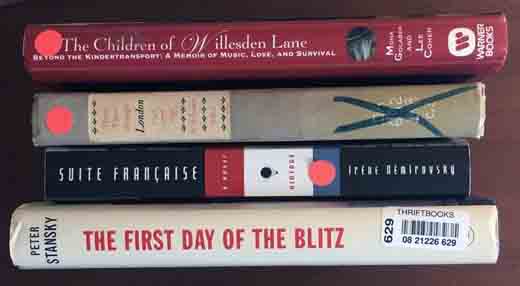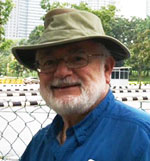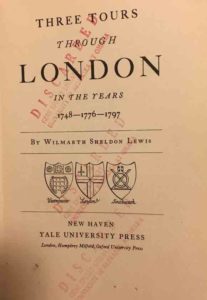
© Oliver B. Pollak

COLOGNE, Germany — I took four books with 1939-1942 hooks on our Germany-Prague-Vienna trip, more than I usually take, and no New Yorker. The recent article by Alex Ross, “How American Racism Influenced Hitler,” was an almost take it along, but it’s on line. My wife gave me the usual caring spiel, your backpack is too heavy, you’ll hurt yourself. But my new Inside Line Equipment “Handmade in California” backpack with a narrow profile, large cabin and not too many zippers, my best ever, lifted my happy wanderer spirit.
The four books present a dilemma, should they be discussed in the order of when written,
when published, when acquired, when read, or provenance – all the above. Historians have been advised that they depart from chronology at their peril. What analytics will serve the reader best?
This trip is qualitatively different. I am semi fixated on my post WWII youth and upbringing, an inherited legacy. In early 2018 I participated in a psycho-drama workshop “Healing the Wounds of History” about a dozen Jews and Germans. Unlike cultural tourism involving art, music and architecture, or academic oriented trips to Burma and Vietnam, this Central Europe adventure is a matter of German and Austrian family heritage, and homes my mother and father fled in the 1930s.
There is a bookshelf in the Jackson, Wyoming, Airport where travelers drop off and pick up books. The three volumes I’ve retrieved in my travels range from light forgettable reading to the profound. In April I snagged Suite Française by Irène Némirovsky. I’d been wanting to read it since its appearance in English in 2006 but other reading intervened. Now a free copy. Ethics require reading free books or giving them away. Limited space prohibits most gratuitous acquisitions. I read Suite in preparation for my roots trip. Némirovsky’s stunning stories about Parisians fleeing to the country side to avoid Nazi bombing in June 1940, echoes Chaucer’s Canterbury Tales, Boccaccio’s Decameron, Proust, Cather, and The Confederacy of Dunces by John Kennedy Toole. Suite has been called the first novel about the Second World War, written up to the time Némirovsky went to Auschwitz in 1942; but not published until 2004, translated into English in 2006, and a film in 2015.
I met Peter Stansky, an inspiring Stanford University historian, in April. I read his work on George Orwell a decade ago. He is working on a biography of Leonard Woolf. I googled Stansky and found The First Day of the Blitz (1940) published in 2007 by Yale University Press. My mother moved in 1944 from London in 1944 to Stoke on Trent to protect the next generation of Britons from Buzz Bombs and V2 rockets. Mother said it was a miserable being a young refugee Jewish mother in unfamiliar and unfriendly terrain. Stansky provides some examples of anti-Semitism in the bomb shelters. Stiff upper lip and carry on mentality were British and survivor assets.
Purchasing Blitz offered interesting possibilities. Abebooks listed 78 copies for between $1 and $93.21. Germany, the agent of the viciousness, had 3 copies, and England, the recipient of the pain, had 31 copies, 7 in London. A three-dollar purchase in the United States prevailed over the more expensive contrived European options.
 Three Tours Through London in the Years 1748, 1776 and 1797 by Wilmarth Sheldon Lewis, is the 21st volume in the Brown University Colver Lectures inaugurated in 1916, and still going. It was published by Yale University Press in 1941. Lewis, born in Alameda, California, and a Yale scholar, amassed the largest Horace Walpole collection. In 1941 the book symbolized American academic support for beleaguered London under fire. Lewis also had sage advice, “Tourists are not expected to see everything.”
Three Tours Through London in the Years 1748, 1776 and 1797 by Wilmarth Sheldon Lewis, is the 21st volume in the Brown University Colver Lectures inaugurated in 1916, and still going. It was published by Yale University Press in 1941. Lewis, born in Alameda, California, and a Yale scholar, amassed the largest Horace Walpole collection. In 1941 the book symbolized American academic support for beleaguered London under fire. Lewis also had sage advice, “Tourists are not expected to see everything.”
The Omaha University library acquired two more copies of the 1952 third printing. Why so many copies? Perhaps they were placed in the Reserve Book Room as required reading for students studying Hanoverian life and the Augustan Age. From 1938 to 1976, Professor Ralph Wardle, a creative presence in the English department, published books on 18th century writers Mary Wollstonecraft, Oliver Goldsmith, William Godwin. and William Hazlitt. Lewis and Wardlem dedicated to 18th century studies, may have known each other. According to pencil gutter notes it was acquired by Omaha University in June 1964 for $3.60 and discarded in the mid-1970s. Perhaps very low circulation of three copies dictated that one had to go. It is stamped “Discarded” in red ink at least ten times. I purchased it for 10 cents marked down from 50 cents.
A well spent dollar purchased The Children of Willesden Lane, Beyond the Kindertransport (2002) by Lee Cohen and Mona Golabek from the Friends of the Library book cart in Point Richmond. I handed it to my sister who brought no reading material for our trip. Our mother, born in 1921 lived in Hannover, also home to Herschel Grynszpan, whose attack against Nazi officials in Paris was the pretext for Kristallnacht, November 9, 1938. Mother effectively blocked out memories of the Night of Broken Glass. She was too old for the Kindertransport, had plans to go to Shanghai, but found safety in England as a nanny, seamstress and bar maid.
The New Yorker writer Alex Ross identifies perennial interest in Adolf Hitler and the origins of WWII as a fixture in the American psyche. Rabid anti-Semitism, The Darkest Hour, The Greatest Generation, Elie Wiesel, genocide, and refugees combine in fiction, day-in-the-life monographs, memoir, autobiography, and biography focused on Hitler’s aberrational psychosis that caused a temporary cataclysm, the results of which still daily confront us.
.
Pollak, a professor emeritus of history at the University of Nebraska at Omaha, is a freelance writer now based in Richmond, California. He may be contacted via oliver.pollak@sdjewishworld.com